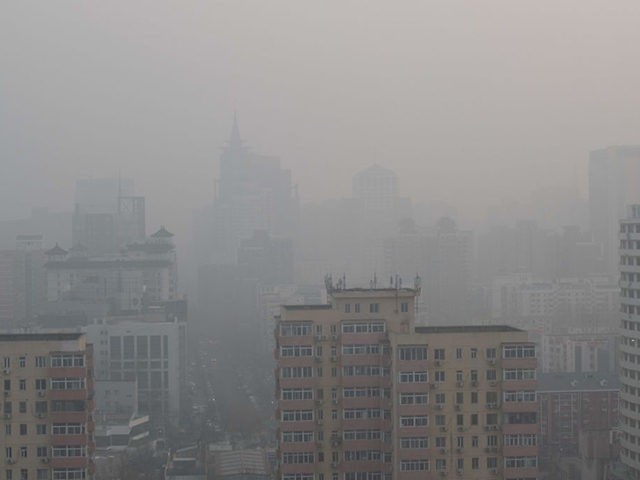Bloomberg Opinion columnist David Fickling noted Wednesday that while China makes all sorts of grandiose promises about reaching “net zero” carbon emissions by 2060, it was the only major economic power in the world that increased pollution in 2020.
That analysis came from a report by the International Energy Agency (IEA) released Tuesday, which found energy demand and “global energy-related CO2 emissions” went down across the world due to the coronavirus pandemic, “the largest annual percentage decline since World War II.”
“Demand for fossil fuels was hardest hit in 2020 — especially oil, which plunged 8.6%, and coal, which dropped by 4%. Oil’s annual decline was its largest ever, accounting for more than half of the drop in global emissions,” the IEA reported.
The exception was China, which significantly increased its annual CO2 emissions, by more than most other industrialized nations reduced them. China’s emissions surged by 7 percent in December 2020 after it became “the first major economy to emerge from the pandemic and lift restrictions.” Chinese emissions ran above 2019 levels from April onward, by an average of five percent each month. The IEA noted China is indisputably “the world’s largest CO2 emitter.”
Fickling described this as a “grim mark” on China’s record as it prepares to release its next five-year economic plan:
If it lives up to Xi’s promise to cap emissions in the coming decade and push them down rapidly thereafter, the world will have started turning the corner on two centuries of carbon emissions, as we’ve argued. If it falls short, our prospects of avoiding the ravages of climate change will dwindle drastically.
The texts of Five Year Plans tend to be a mixture of Communist Party jargon, airy pabulum, and a few solid material targets. It’s the latter that will determine whether this year’s is worth more than the paper it’s written on.
Fickling laid out a grandiose vision for China becoming massively reliant upon expensive and unreliable green energy sources that bears no resemblance whatsoever to what China is actually doing, which is building gigantic amounts of reliable, affordable, and carbon-spewing coal-fired electrical capacity.
The Chinese built three times as much coal capacity as the rest of the world combined in 2020. They build plants that will probably never repay the cost of construction, plants that generate more capacity that it seems Chinese industry could possibly use unless one assumes everything the Chinese Communist Party (CCP) says to gullible environmentalists about carbon neutrality is just a ruse to make Western economies cripple themselves — and trick them into buying more of the green power equipment China manufactures — while Beijing plans a future of explosive industrial growth and ravenous energy consumption for itself.
Forbes on Tuesday quoted analysts certain China will make that big lunge for carbon neutrality any day now, fairly quivering with excitement over news that the vast Communist bureaucracy plans to start making power plant administrators report how much carbon their operations are emitting:
The country’s long-awaited national emissions trading scheme officially launched on February 1, covering some 2,225 coal and gas power plants and other facilities across the country. Although initially the scheme is designed to do little more than encourage some number crunching, including accurate gathering and reporting of emissions data, the Ministry of Environment and Ecology, its administrator, will eventually begin tightly restricting the total emissions that China’s vast fleet of power plants is allowed to release, effectively firing up the engine of the biggest environmental scheme of its kind in the world.
“China’s nation-wide rollout of the emissions trading scheme is a giant step,” said Prakash Sharma, an analyst at consultancy Wood Mackenzie. “Nothing of this scale has been tried or implemented in the world before.”
Lauri Myllyvirta, lead analyst at the Centre for Research on Energy and Clean Air, a research outfit, agreed: “As a bureaucratic or a regulatory undertaking, this is incredibly ambitious.”
Forbes then let some of the greenhouse gas out of this fanciful environmentalist balloon by noting China’s carbon tracking scheme is “far smaller in scope than initially envisioned when it was first mooted in 2015” and “may not be fully up and running for as many as three to five years,” which would give the Chinese enough time to complete “hundreds of new coal power generation units.”
Furthermore, based on the past behavior of Chinese bureaucrats, there is little reason to believe emissions would be reported honestly, or that Beijing would do anything meaningful with the data. The emissions tracking initiative does not pretend to limit emissions — its only clear goals for the moment involve getting power plant administrators to fill out the reporting paperwork, with only wrist-slap fines for those who refuse. The clear primary objective for Chinese officials, supported by all of the Communist bureaucracy’s serious penalties and incentives, is increasing economic growth.
And yet, the environmentalists Forbes and Bloomberg quoted remained unshakably convinced Beijing is ultra-serious about achieving carbon neutrality, even as the economy-destroying drastic actions China would have to take to meet those goals grow more fanciful.
“For all the unknowns about the scheme, though, one thing is clear, most analysts emphasize: China’s seriousness about achieving its 2060 net-zero carbon emissions target. And while the precise path to get there yet hasn’t been laid down, the policy architecture is gradually being lowered into place,” Forbes concluded wistfully.

COMMENTS
Please let us know if you're having issues with commenting.